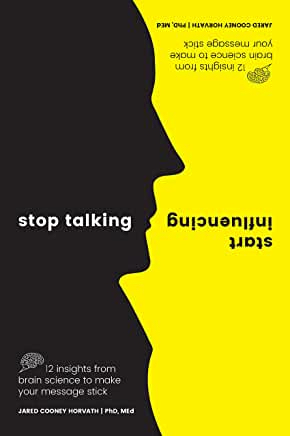By William Carmichael
Rarely has a book caught and held my attention as quickly as this one. Let me put it this way; if you want to better understand how to impart knowledge and positively impact others, you need this book! Stop Talking Start Influencing: 12 Insights from Brain Science to Make Your Message Stick by Dr. Jared Cooney Horvath, is the most engaging and practical guide about how and why our brains work you will ever read! Perhaps a better way to say it comes directly from an endorsement in the book; “You don’t read this book, you experience it!”
PowerPoint Presentations Need Change!
Despite its business-like title, Stop Talking, Start Influencing is a wonderfully enjoyable foray into how and why the brain functions. From the very first page Dr. Horvath offers us a candid view of brain science and its direct applications within business and education. Take for example the presentation program- PowerPoint; a visual design we all have come to use and rely upon. Here, we assume content and imagery blend. Even seasoned instructional designers are taught the intricacies of slide design yet are rarely instructed about the potential fallacies of this process. In other words, to question what makes a slide effective to the viewer and why. As an example, we all include visuals and bullet points when, in fact, maybe only the visual is needed. For many, this concept flies in the face of accepted norms doesn’t it? Yet, our author offers one of the best explanations for why too much text during a presentation can hinder understanding. He carefully combines explanations of the underlying neuroscience with practical tips on how to present things more clearly. PowerPoint, as it turns out, serves as only one practical point of entry for us. Early on, readers will encounter the misinterpretations about reading, conversation, speech formation, mental stressors, cognition and recall each of us has.
What is Going On?
As an expert in Educational Neuroscience, Dr. Horvath certainly understands the nuances of brain function but it is his ability to explain those subtle gradations in an entertaining, matter-of-fact manner has endeared him to those in education and industry alike. Throughout Stop Talking, Start Influencing, the author introduces us to different parts of the brain, addressing topics such as how space, sound, and context influence memory. He describes why we cannot text while carrying on a conversation but why we can listen to music while driving. Why is it also that when our conscious is speaking to us it appears identical to our own voice but whenever we remember a song, we hear it in the singer’s voice. But every idea that he introduces is shaped around implications for business and teaching. And most importantly, he teaches us the 12 core concepts of how people think, learn and remember. As an example, can you name all the human senses and the purpose for each? Well, if you named the big five- the faculties of sight, smell, hearing, taste, and touch, you would only be partially correct. There are many more and each influences our ability to effectively influence others.
Can You Multitask?
This book also takes you through more familiar territory, such as errors, feedback and misconceptions. Take, for example, multitasking; a function of memory, which we each pride ourselves in being able to do, is actually not possible. As disappointing as this may be, our brains simply won’t allow it. Instead, a different rule-set called “task-switching” takes over. This same fallacy can also be said for memory; the faculty by which the mind stores and processes information. We have always assumed that memory retrieval comes from one area of the brain as a singular event, when in fact, memories come from many different parts of the brain and for very specific reasons. Regardless of how we thought multitasking or memory occurs, Dr. Horvath explains exactly what these reasons are and how we can use the information to our betterment. Each discussion is also rooted in neuroscience, which readers will find refreshing and thought-provoking.
Structure and Layout
At first glance the book resembles a textbook but this is delightfully deceiving. Its twelve short chapters or insights can easily be read over a weekend although I found it to be a page turner. Linear by design, Dr. Horvath promises foundations explored in this book are supported by scientific research, and everything will make perfect sense by the time you reach the end. Interspersed throughout the pages are diagrams, activities, clearly explained concepts and, most importantly, a sense of humor.
What will make it most appealing to readers however is a repetitive schema found within each chapter consisting of:
- Implications for leaders, teachers and coaches
- Fundamentals of concepts
- Applications
As an experienced educational neuroscientist and university professor, our author does not assume readers will simply take his word for it. Significant medical research and findings are evidenced throughout. Now for our HR and legal readers out there who are interested in improving their speaking and presentation skills, Stop Talking Start Influencing: 12 Insights from Brain Science to Make Your Message Stick will introduce you to approaches you can immediately use!
Who Will Benefit Most from This Book?
Managers, HR Professionals, Speakers, Trainers, Teachers and Instructional Designers
About the author: Dr. Jared Cooney Horvath, PhD, MEd, is an expert in the field of Educational Neuroscience. He has conducted research and lectured at Harvard University, Harvard Medical School, the University of Melbourne, and over 100 schools across four continents.

Ed.D Professor | Strayer University william.carmichael@strayer.edu www.strayer.edu
